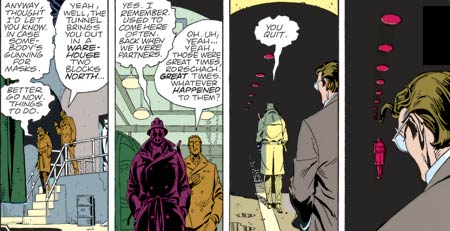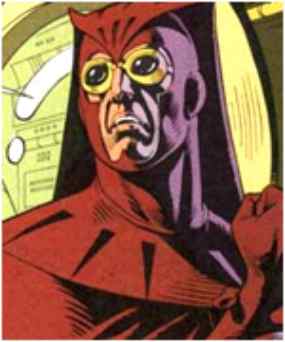- Comics
- Comics Reviews
- Manga
- Comics Reviews
- European Comics
- News
- Comics News
- Press Releases
- Columns
- Spotlight
- Digital Comics
- Webcomics
- Cult Favorite
- Back Issues
- Webcomics
- Movies
- Toys
- Store
- More
- About
By Andy Frisk
February 24, 2009 - 19:30
Daniel Dreiberg, aka Nite Owl II (“II” because he is the second character in the Watchmen universe to wear the owl cowl) is at once Watchmen’s most simple yet engagingly complex characters as he is, perhaps, the most easily identified with and metaphorically relevant character in the story.
As Alan Moore himself stated in the Absolute Watchmen edition’s “Nite-Owl” bonus section “…this character is the nearest we get to a conventional superhero.” He’s also the closest we get to a conventional man and Thoreau’s mass of men who live lives “of quiet desperation.” Dreiberg, though, is one of the most dynamic characters in Watchmen and doesn’t remain in a state of desperation. He does what all men wish to do when they face what, to them, amounts to a mid-life crisis. Dreiberg regains his youth at least in his outlook on life through the re-engagement of his superhero life. His story is a metaphor for more than just middle aged men who recapture a moment of youth. Dreiberg and his costumed persona are metaphoric of the greater questions in life: to what purpose am I given? Do I have the strength to live up to that purpose? Finally: Can I follow my passion, whatever it is for?
We first meet Dreiberg in Chapter I at the, original Nite-Owl, Hollis Mason’s residence, where he is listening to Mason recount a story of his recent run-in, at the grocery store while shopping, with a super-villain, also retired and past his prime, as well as reformed. We’re immediately struck by the generational age difference between Dreiberg and Mason, yet Mason states that “us old retired guys gotta stick together.” Also, we find out that Dreiberg is spending his Saturday nights in “beer-sessions” with Mason. Obviously, it is honorable and noble of Dreiberg to show the amount of respect he does by spending time with Mason, but it is painfully obvious that Dreiberg is allowing himself to be aged beyond his years prematurely through such close camaraderie with Mason.
Dreiberg takes his leave of Mason and upon arriving home discovers Rorschach, the only non government sponsored masked hero still operating, in his kitchen. Rorschach informs Dreiberg of the recent murder of The Comedian, the focal event of the graphic novel that gets the plot moving, and after an awkward exchange which ends with Dreiberg remembering the good old days of his and Rorschach’s partnership and “whatever happened to them?”, Dreiberg is left alone in his old Nite-Owl headquarters surrounded by the trappings of his superheroing days gone by, totally defeated by Rorschach’s response: “You quit.”
 |
Granted, Dreiberg retired because of The Keene Act of 1977 which essentially outlawed all masked heroes unless registered with the government’s blessing. This is the event that “forced” Dreiberg into retirement. He could have made a choice though, to continue his crime fighting exploits like Rorschach has. Later on, at dinner with Laurie Juspeczyk, aka the former Silk Specter and soon to be ex-lover of Dr. Manhattan, we see that Dreiberg is carrying around The Comedian’s blood stained button, retrieved from his murder site. The button, thrown down on Dreiberg’s table by Rorschach during his visit, like a gauntlet, a challenge to regain his identity as Nite-Owl and help him solve the mystery of The Comedian’s murder, is a gauntlet that Dreiberg is now carrying, if not picking up and donning…yet.
As Dreiberg’s journey toward the regaining of his identity as Nite-Owl progresses, two key events compel him toward the decision to don the cowl again: his impotent attempt at a physical relationship with Laurie, and his dream of both rebirth and death. In this dream sequence Dreiberg imagines both he and Laurie, engaged in a lover’s embrace, stripping off their skins to reveal their hero costumes underneath only to die in the blast of a thermo-nuclear detonation. Dreiberg, shocked awake by this disturbing dream enters his underground headquarters and at Laurie’s suggestion finally becomes Nite-Owl again, and with her as Silk Specter by his side takes Archie, his Owl Ship, out on patrol. After both newly re-costumed heroes rescue the tenants of a burning building, Dreiberg is finally able to consummate his relationship with Laurie, metaphorically re-consummating his relationship with life itself as well as his passion for his purpose in life: super-heroing.
Dreiberg’s journey from a prematurely aged, impotent and defeated man living a life of quiet desperation, in a safe, acceptable and passionless way to preternaturally young, virile, victorious superhero re-living his passion and rediscovering that one can live passionately up to one’s purpose, is easily the most dynamic action taken by any character in Watchmen and the most important. Dreiberg/Nite-Owl is the most important character in Watchmen because he is the most realistic and realistically imitable character in the tale. While Dr. Manhattan, with his attainment of near god-hood and master of the very secrets of life is an engaging character, the possibility of attaining the knowledge he does is unrealistic, if even imaginable. Likewise, while Rorschach’s romantically appealing freedom and existence outside the confines of societal mores and morals makes for attractive escapism, Rorschach’s life is dangerously self-destructive and only fancifully attainable at best, even metaphorically. Dreiberg/Nite-Owl’s attaining of a passion filled life is very existentially attainable and is actually not really a metaphor upon closer inspection but an actual imitable act that we as readers can take to heart and actually put into practice in our lives.
 |
How many of us are leading lives of quiet desperation either reminiscing upon times past when we were high school sports stars, or politically and intellectually engaged thinkers and debaters who stayed up with friends late into the night and early into the morning unlocking the secrets of the universe? How many of us, as adulthood took hold found ourselves bound by work-a-day life duties “working jobs we hate, to buy (expletive deleted) we don’t need” (thank you Tyler Durden for all your words of wisdom).
The question we should be asking, and what Dreiberg/Nite-Owl does in his own way through the example of his actions in Watchmen is: How many of us “picked up the cowl” again and formed a weekend football or baseball league to reinvigorate ourselves physically? How many of us either re-entered the academic world or sought out literary or politically active clubs of like-minded men and women and re-engaged the asking of questions that lead to the unlocking of the secrets of the universe, at least in our own minds? How many of us picked up a pen and put it to paper to once again write, this time reviews or articles on an art form they love and dared to share their thoughts with others? How many of us not just “picked up the cowl” but “donned the cowl” in an effort to reignite our passions and purpose? How many of us shed or at least beat back our desperation and feelings of impotence to effect change in our worlds and lives, at least part time, possibly even at night, albeit without the help of an owl ship or fancy gadgets?
Dreiberg did. He beat back his impotent, desperate, pre-maturely aged existence with the help of an old friend turned new lover but more importantly by remembering and daring to be what he was passionate about: being a superhero. We all are being superheroes when we take the steps in our own lives to live and love passionately, and to acknowledge our purpose and talents, whatever they are. The journey Dreiberg takes to becoming Nite-Owl again is an inspiring one of change, rebirth and growth at the heart of
Watchmen, and its most important story and lesson.